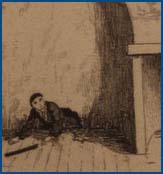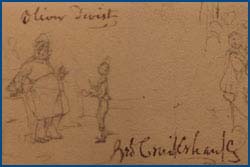|
When Is a Book Not a Book? Oliver Twist in Context Section 4. The Influences of Victorian CultureA third point of interest about Oliver Twist's original publication is that serial fictions, not being self-contained, incorporate the times. Eminent scholars have identified many topics of the day to which serials make reference. The topicalities of periodical fiction tend to be journalistic, metropolitan, topographical, sensational, and narratable. For instance, the gradual spread of a mysterious form of equine hoof disease might throw the Scottish highlands into a panic, but though topical, it probably would not become the subject of a successful serial fiction: it would not make the daily newspapers, would not appeal to city dwellers, could not be located in a familiar neighborhood or landmark building, would not accelerate the pulses of readers seeking sensation and could not be cast as an enthralling narrative. Murder, on the other hand, fulfills all the requirements and by the 1850s was a leading subject of periodical fiction. The ideologies of an era There are other anxieties of the late Regency and early Victorian periods that ally with this fear of alienable identity. George Cruikshank and the Fraser's crowd, especially Harrison Ainsworth, were as we have seen interested in the lives of thieves. "Crime," Martin Wiener notes in Reconstructing the Criminal: Culture, Law, and Policy in England, 1830-1914 (1990), "was a central metaphor of disorder and loss of control in all spheres of life." This interest in crime related to perennial debates about nature versus nurture, that is, whether a bad character was innate like a bad seed or produced by a bad environment. A related issue vexed Charles Dickens for decades: did parental neglect foster in the child a determination to succeed in respectable society (Charles Dickens) or did it lead to criminality (the Artful Dodger) and/or death (Oliver's orphan friend Dick)? The early Victorian cultural fascination with criminality seemed to find particular expression in the dramas of incarceration and excarceration. Many critics have noted the cramped, confined world of Dickens's and Cruikshank's collaborations—the sense of structures, persons, environments, laws, and fortune closing down, squeezing, deforming the individual. Such paradigms do seem to reflect the cultural emphasis on policing the self that bourgeois industrial capitalism promulgated. Conversely, and less often noticed, there is in the 1830s an equal interest in escape, excarceration, in how individuals might defy those pressures that could identify and fix them. Nowhere is that escapism more celebrated than in Jack Sheppard. This was the serial Harrison Ainsworth wrote, and that began to appear at the front of each issue of Bentley's Miscellany after Oliver Twist had been published in three volumes but while it was still running in installments in the periodical. The letterpress by Ainsworth and the illustrations by Cruikshank celebrate the eighteenth-century prison escapist Jack Sheppard, an idle and foolish apprentice who is unfairly bedeviled by the law and repeatedly foils its attempts to imprison him. In the text and pictures and later in the theatre, his famous escapes from Newgate prison stage his eel-like ability to slip out of shackles and cells. They also dramatize the site of the old Newgate prison, as Fagin's time in the condemned cell, like the earlier sketch "A Visit to Newgate" in Sketches by Boz, brings to life the modern prison. Had Dickens continued as editor of Bentley's Miscellany and Cruikshank continued as illustrator, their next collaborative serial fiction, following Jack Sheppard in the magazine, would have been Barnaby Rudge, a story about the burning of the old Newgate prison. The title Dickens originally assigned to that work was Gabriel Vardon, the Locksmith of London, one that again plays on the theme of incarceration and excarceration. And so, within the pages of Bentley's Miscellany, all illustrated by Cruikshank, would have appeared three serial fictions about crime, dealing in sequence with the modern Newgate (Oliver Twist), the old Newgate of the eighteenth century (Jack Sheppard) and Newgate's partial destruction during the Gordon Riots in 1780 (Gabriel Vardon). These unrealized plans for a triple serial on prisons illustrate one way magazine publication shows deep ideological currents that separate book publication obscures. Aesthetic issues and Victorian periodicals At the time of Oliver Twist, journalist William Maginn was producing for Bentley's Miscellany a series of articles on character in Shakespeare that are, in Kathryn Chittick's judgment, "of impressive acuteness." His was another way of directing reading, writing, social and punitive practices, as well as commenting on theatricality—all themes touched on in this essay. One of Maginn's papers, about the villain Iago in Othello, appears at a crucial spot in the journal: between the first chapters of Ainsworth's Jack Sheppard, about an eighteenth-century boy thief, and the last chapters of Dickens's Oliver Twist, about nineteenth-century boy thieves. In this paper Maginn implicitly argues against Samuel Taylor Coleridge's notion that Iago's actions can only be explained as the product of "motiveless malignity." All Shakespeare's characters, he says, "are real men and women, not mere abstractions." Their virtues and vices are compounded "and are not unfrequently blended." Maginn maintains that wickedness is prompted by the same impulses that stimulate persons "to the noblest actions—ambition, love of adventure, passion, necessity." Thus, in an article printed between the opening of Jack Sheppard and the chapters of Oliver Twist recounting Sikes's last day and Monks's capture, Maginn ventures to say that "the creatures of Boz's fancy, Fagin or Sikes, did not appear in every circle as the unmitigated scoundrels we see them in Oliver Twist." It is due to the exigencies of the story, Maginn reasons, that readers see only one side of their characters. "But, after all, the Jew [Fagin] only carries the commercial, and the housebreaker [Sikes] the military principle to an extent which society cannot tolerate." Maginn uncovers an aesthetic that appeals more to empathy and capitalistic entrepreneurship than to social controls. The feeling that covers the globe with shipping, he says, also animates the breasts of thieves and highwaymen: "Robber, soldier, thief, merchant, are all equally men." (No wonder arch-conservative Mary Russell Mitford hated the idea of making lawbreakers attractive and police venal.) In conclusion, Maginn calls for yet another inscription of the Hogarthian "progress" contrasting industry and idleness: "It would not be an unamusing task to analyze the career of two persons starting under similar circumstances, and placed in situations not in essence materially different, one ending at the debtors' door of Newgate amid hootings and execrations, and the other borne to his final resting-place in Westminster Abbey, graced by all the pomps that heraldry can bestow."Thus Maginn's serial criticism of Shakespeare's characters accomplishes five things. One, it establishes an aesthetic principle—successfully drawn characters are compounded of good and evil. Two, it derives reading practices from that principle—readers should recognize and empathize with motives that lead to bad actions as well as to good ones. Three, it declares a moral order—"robber, ... merchant, all are equally men." Four, it relates dramatic criticism to the magazine's current serial fictions—Fagin and Bill Sikes are also "equally men," appearing much more lovable and redeemable offstage, out of the plot. And five, Maginn's essay sets an agenda for future writings—another fiction contrasting the industrious and idle apprentice. In such ways, this and the many other articles interspersed with poetry and serialized fiction collectively articulate the aesthetic presumptions and reading practices that inform the journal and affect its contributions.
|

